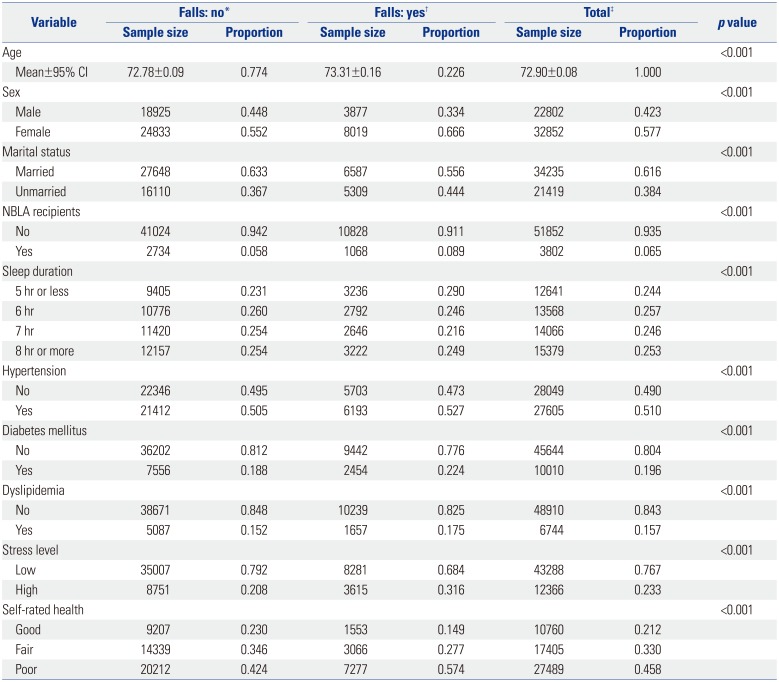1. United Nations Population Division. World population prospects: The 2012 revision. NY: United Nations Population Division;2013.
2. Schlicht J, Camaione DN, Owen SV. Effect of intense strength training on standing balance, walking speed, and sit-to-stand performance in older adults. J Gerontol A Biol Sci Med Sci. 2001; 56:M281–M286. PMID:
11320107.

3. Ryan JJ, McCloy C, Rundquist P, Srinivasan V, Laird R. Fall risk assessment among older adults with mild Alzheimer disease. J Geriatr Phys Ther. 2011; 34:19–27. PMID:
21937888.

4. Tinetti ME, Speechley M, Ginter SF. Risk factors for falls among elderly persons living in the community. N Engl J Med. 1988; 319:1701–1707. PMID:
3205267.

5. Kiel DP, O'Sullivan P, Teno JM, Mor V. Health care utilization and functional status in the aged following a fall. Med Care. 1991; 29:221–228. PMID:
1997751.
6. O'Loughlin JL, Robitaille Y, Boivin JF, Suissa S. Incidence of and risk factors for falls and injurious falls among the community-dwelling elderly. Am J Epidemiol. 1993; 137:342–354. PMID:
8452142.
7. Rubenstein LZ, Josephson KR. Falls and their prevention in elderly people: what does the evidence show? Med Clin North Am. 2006; 90:807–824. PMID:
16962843.

8. Ruchinskas R. Clinical prediction of falls in the elderly. Am J Phys Med Rehabil. 2003; 82:273–278. PMID:
12649652.

9. Latimer Hill E, Cumming RG, Lewis R, Carrington S, Le Couteur DG. Sleep disturbances and falls in older people. J Gerontol A Biol Sci Med Sci. 2007; 62:62–66. PMID:
17301039.
10. Strine TW, Chapman DP. Associations of frequent sleep insufficiency with health-related quality of life and health behaviors. Sleep Med. 2005; 6:23–27. PMID:
15680291.

11. Vitiello MV. Sleep disorders and aging: understanding the causes. J Gerontol A Biol Sci Med Sci. 1997; 52:M189–M191. PMID:
9224429.

12. Crowley K. Sleep and sleep disorders in older adults. Neuropsychol Rev. 2011; 21:41–53. PMID:
21225347.

13. Ancoli-Israel S, Ayalon L, Salzman C. Sleep in the elderly: normal variations and common sleep disorders. Harv Rev Psychiatry. 2008; 16:279–286. PMID:
18803103.

14. Duffy JF, Cain SW, Chang AM, Phillips AJ, Münch MY, Gronfier C, et al. Sex difference in the near-24-hour intrinsic period of the human circadian timing system. Proc Natl Acad Sci U S A. 2011; 108(Suppl 3):15602–15608. PMID:
21536890.

15. Vitiello MV, Larsen LH, Moe KE. Age-related sleep change: gender and estrogen effects on the subjective-objective sleep quality relationships of healthy, noncomplaining older men and women. J Psychosom Res. 2004; 56:503–510. PMID:
15172206.
16. Shinkoda K, Naminohira K, Anan M, Shinkoda H. Is sleep duration a risk factor for falls in the elderly? Physiother. 2015; 101:eS1393.

17. Mesas AE, López-García E, Rodríguez-Artalejo F. Self-reported sleep duration and falls in older adults. J Sleep Res. 2011; 20(1 Pt 1):21–27. PMID:
20626611.

18. Kuo HK, Yang CC, Yu YH, Tsai KT, Chen CY. Gender-specific association between self-reported sleep duration and falls in high-functioning older adults. J Gerontol A Biol Sci Med Sci. 2010; 65:190–196. PMID:
19793798.

19. Lee KA, Gay C, Portillo CJ, Coggins T, Davis H, Pullinger CR, et al. Types of sleep problems in adults living with HIV/AIDS. J Clin Sleep Med. 2012; 8:67–75. PMID:
22334812.

20. McDonald M, Hertz RP, Unger AN, Lustik MB. Prevalence, awareness, and management of hypertension, dyslipidemia, and diabetes among United States adults aged 65 and older. J Gerontol A Biol Sci Med Sci. 2009; 64:256–263. PMID:
19181717.
21. Lim S, Shin H, Song JH, Kwak SH, Kang SM, Yoon JW, et al. Increasing prevalence of metabolic syndrome in Korea: the Korean National Health and Nutrition Examination Survey for 1998-2007. Diabetes Care. 2011; 34:1323–1328. PMID:
21505206.
22. Ancoli-Israel S, Ayalon L. Diagnosis and treatment of sleep disorders in older adults. Am J Geriatr Psychiatry. 2006; 14:95–103. PMID:
16473973.

23. Kawamoto R, Doi T. Sleep problems as a risk factor for fall in community-dwelling older persons. Geriatr Gerontol Int. 2002; 2:16–22.

24. OECD. Special focus: measuring leisure in OECD countries. Paris: OECD;2009.
25. Stone KL, Ewing SK, Lui LY, Ensrud KE, Ancoli-Israel S, Bauer DC, et al. Self-reported sleep and nap habits and risk of falls and fractures in older women: the study of osteoporotic fractures. J Am Geriatr Soc. 2006; 54:1177–1183. PMID:
16913982.

26. Youngstedt SD, Kripke DF. Long sleep and mortality: rationale for sleep restriction. Sleep Med Rev. 2004; 8:159–174. PMID:
15144959.

27. Vitiello MV, Smallwood RG, Avery DH, Pascualy RA, Martin DC, Prinz PN. Circadian temperature rhythms in young adult and aged men. Neurobiol Aging. 1986; 7:97–100. PMID:
3960269.

28. Cappuccio FP, Cooper D, D'Elia L, Strazzullo P, Miller MA. Sleep duration predicts cardiovascular outcomes: a systematic review and meta-analysis of prospective studies. Eur Heart J. 2011; 32:1484–1492. PMID:
21300732.

29. Leng Y, Cappuccio FP, Wainwright NW, Surtees PG, Luben R, Brayne C, et al. Sleep duration and risk of fatal and nonfatal stroke: a prospective study and meta-analysis. Neurology. 2015; 84:1072–1079. PMID:
25716357.
30. Wang Y, Li W, Shen L, Song L, Li H, Liu B, et al. Association between nighttime sleep duration, sleep timing and falls among middle-aged and older Chinese population: a cross-sectional analysis from the Dongfeng-Tongji cohort study, China. Geriatr Gerontol Int. 2017; 2. 08. [Epub ahead of print]. DOI:
10.1111/ggi.12984.








 PDF
PDF ePub
ePub Citation
Citation Print
Print



 XML Download
XML Download